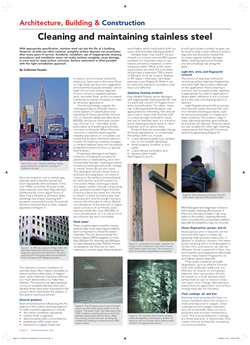Surface finish selection is critical to achieving aesthetic goals but it can also have a tremendous influence on corrosion performance and, even in less corrosive environments, dirt accumulation.
Finish options
Stainless steel finishes are available in a wide range of mechanically applied patterns, textures, and colors. Etched patterns are also available. It is not uncommon to combine techniques to achieve unique finishes. There are numerous resources to assist with aesthetic finish selection:
3D Finishes, EuroInox
Colored Stainless Offers a Rainbow of Possibilities, SMACNA
Colouring Stainless Steel, EuroInox
Electropolishing Stainless Steels, EuroInox
European Finishes for Stainless Steel, BSSA
Guide to Stainless Steel Finishes, EuroInox
Mechanical Finishing of Decorative Stainless Steel Finishes, EuroInox
Special Finishes for Stainless Steel, SSINA
Standard Finishes for Stainless Steel Interactive Web Brochure, SSINA
Surface Finishes, ASSDA
Corrosion performance
The relationship between surface roughness and susceptibility to corrosion of materials (i.e. not just stainless steel) is well known. Rougher surfaces accumulate more dust, debris and corrosive substances from the environment, such as industrial pollutants and coastal and deicing salts. Their higher surface tension means that they also retain the moisture that is needed for corrosion to occur for longer periods of time.
This relationship is discussed in Stainless Steel and the Challenge of Time, EuroInox and Guidelines for Corrosion Prevention, Nickel Institute.
Textured finishes (i.e. coined and embossed) are slightly different than other rougher surfaces, consisting of patterns pressed into the surface. Typically, the underlying surface is a very smooth 2B or BA mill finish, which inherently retains fewer deposits. The ability of the chosen pattern to be easily rain-washed needs to be assessed.
Specifying low sulfur austenitic stainless steel (e.g. 316) sheet, strip and plate is important for both appearance and corrosion resistance - see Stainless Steel: A Perfect Mirror Finish, The Construction Specifier.
IMOA has developed a scoring system and case studies to provide guidance with finish and alloy selection -see Which Stainless Steel Should Be Specified For Exterior Applications, and the links to information sources on different corrosion environments.
Specifications
It is important to use internationally recognized finish specifications. They provide legal protection for the buyer and seller and help to more clearly define requirements. However, specifiers must understand that standards describe how finishes are applied but do not provide enough detail to ensure consistency.
Specifiers therefore need to work closely with suppliers to precisely define the finish using parameters such as surface roughness range, reflectivity (gloss), and more specific aspects of appearance, such as color range. Visual standards must be agreed by suppliers and matched for aesthetic applications. Many special finishes are not covered by standard specifications and should be described in as much detail as possible. For further information, see IMOA/Nickel Institute International Specifications, Guidelines and Industry Associations list.
Finish measurement resources
New Primary Standard for Specular Gloss Measurements, NIST
Specular Gloss, NIST Special Publication SP250-70
Surface Color, NIST
Roughness Measurements of Stainless Steel Surfaces, EuroInox

